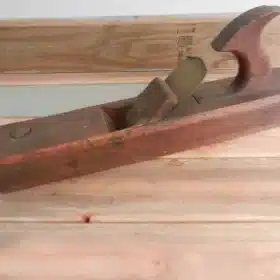Woodworking Tools
Block Plane For Kids
Block Plane For Kids
A plane is tool used to shape wood. The plane is used to smooth out rough lumber, flatten it, reduce its thickness, and give it a smoother surface. The tool’s name suggests that it turns the surface into a flat plane.
Hand planes consist of a combination of a sharpened metal blade and a solid body that, when used on a wood surface will produce shavings of relatively equal size. This is because the body rides over the “high spots” in the wood.
Hand planes have been around for thousands of years. The first planes were made of wood, and the blades were bronze. Later they switched to iron. And even later they changed to steel. A wooden wedge was used to hold the cutting blade or iron in place.
Contents
Plane Parts
Plane parts
The parts of two styles of planes are labeled. The image at the top shows a bench plan; the one at the bottom, a blockplan.
- The mouth is a hole in the bottom of a plane through which the blade extends and wood shavings pass.
- The iron plate is made of steel and has a sharpened edge that cuts wood.
- The Cap secures the blade firmly against the body of your plane.
- The Depth Adjustment Knob controls the length of the blade through the mouth.
- The knob is the handle at the front of the aircraft.
- The chipbreaker and cap iron serve to stiffen the blade and curl and break up wood shavings when they pass through.
- The Lateral Adjustment Lever is used for adjusting the iron to ensure that the cut depth is uniform throughout the mouth.
- The Tote has a handle at the back of the plane.
- The finger rest knob block planes is held in the palm. The tip of the index finger of the user rests on the indentation at the top of knob.
- The frog holds the plane Iron in the correct angle. The frog slides to adjust the distance between the cutting edge of the plane and the front mouth. The frog screws into the inside sole of the plane through two parallel slots. On many planes, it can only be adjusted with a screwdriver after removing the plane iron.
Types of planes
Modern wooden plane
The name and size of each bench plane is determined by its use. The planes are designed to be used:
- A scrubbing plane is usually around 9 inches long (230 mm), but it’s narrower than the smoothing plane.
- The Jack plane, which is about 14 inches long (350 mm), continues roughing out but with greater accuracy than the scrub.
- The joiner plane is 18-24 inches (450-600mm) in length and is used to flatten out boards and joint them.
- To prepare the surface, a smoothing plan up to 10″ (250 mm) in length is used.
The material from which planes are made can also be used to classify them:
- The blade of a wood plane can be made from any material, except for wood. The iron is inserted into the plane using a wooden wedge and adjusted with a hammer.
- A Transitional Plane is a wooden plane with a metal casting in it that holds and adjusts the blade.
- The handles of a metal plan are made from metal. The planes shown in the picture are metal planes.
- A infill plan is a plane with a metal body filled with wood, on which the blade rests. These planes are used primarily to cut cross-grained woods.
There are many types of aircraft, including:
- The shoulder plan trims tenons, and other joints.
- The moulding plan is used to mould mouldings around the edge of a piece of board
- The rebate plane is also known as an openside plane or rebate plane. It cuts dadoes and rabbets.
- The router plan is used to cut grooves and shallow mortises.
- The plane chisel removes wood to a perpendicular area, such as the bottom of a box.
- Use the finger plan to smooth out very small pieces, such as toys, thin strips of wood and so on.
- The Bullnose Plane is a plane that has no front on the body and can therefore be used to fit into tight spaces, such as on the backs or large joint-knobs.
- The Combination plane combines the functions of a moulding plane and rabbet plan, with different cutters and adjustment.
- circular plane is a compass plane that uses an adjustment system to control flex in a steel sheet and create a consistent curve. Concave settings are ideal for large curves such as table sides and chair arms. The convex setting is best for chair legs, arms and backs.
Tips To Keep Kids Engaged And Happy
1. Fun is the key – If kids enjoy what they are building, they will pay more attention. Also, they’re more likely to return to your shop.
2. Small Time Blocks – While an adult’s focus can last for hours, a child might only be able to concentrate for a few minutes. It’s normal, so don’t push them past their limits.
3. It is important to leave the shop intact. It is important to have eye protection that does not slide down the nose. A dust mask should also fit and work.
4. Be patient – The machines, power tools, and hand tools are all new to children, as is the concept of how to complete a simple project. The patience will help a child absorb the information they need at their own pace.
5. It’s OK to Teach a Little, but Not Too Much. If my children are unfamiliar with a tool or machine we will be using, I explain it briefly and discuss the key points. Then I watch them closely to ensure they don’t injure themselves. Too much information is only going to complicate the situation.
6. Show Them How – My kids often ask me to show them how to do something before they attempt it. They are picking up everything, from the speed of feed to where they should put their hands to what sound a machine or tool makes.
7. Show them What They Want – If your child wants to know what the compressor does, then show him. It’s best to let them learn about what they are interested in.
8. Hand tools are a good place to begin. They’re safer and quieter, so they make a great starting point. Hand tools also do not ruin work pieces as quickly as power tool can. If your child only wants to use power tools, then you should proceed with caution and choose the safer alternatives.
9. Keep Your Tools Sharp. This is a rule that should be followed in every shop. A beginner woodworker does not need to struggle with dull tools.
10. Buy Them Their Own Equipment – An apron and pencil, a 6″ rule, a tape measure, PPE, and a set drill/driver bits can get them excited about the workshop and make them feel as if they belong.
It is always hard to keep kids happy and engaged, especially with tools and woodworking when it needs your 100% attention and you cannot leave them to be most of the time. Using a plane is for older children but it is a rewarding skill as they go through life. Anyone who can fix a door or window in life will always be admired!

